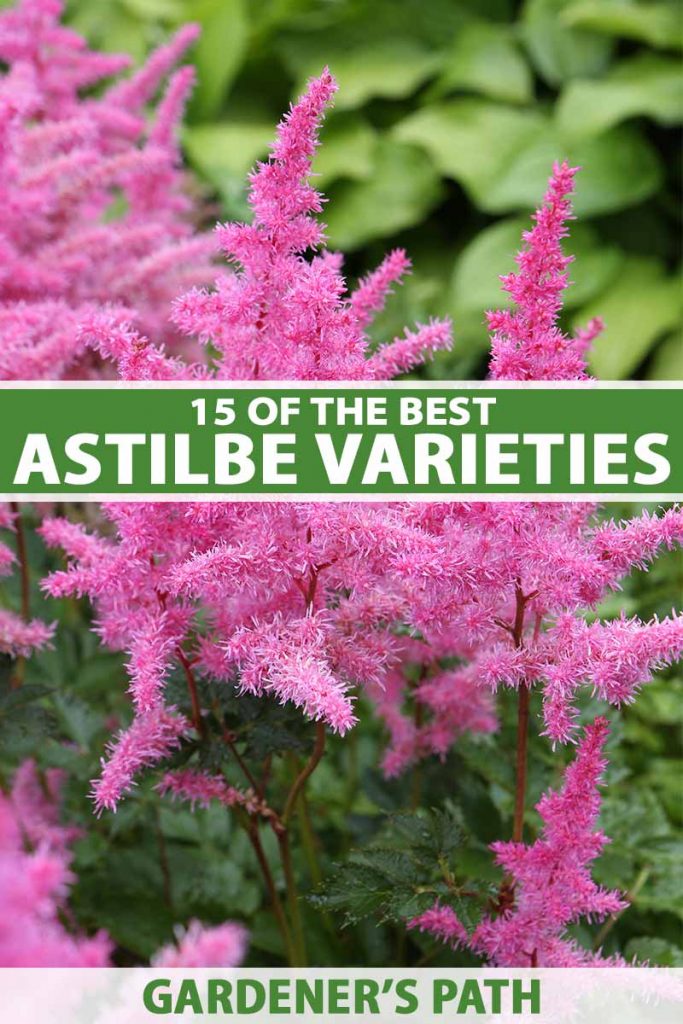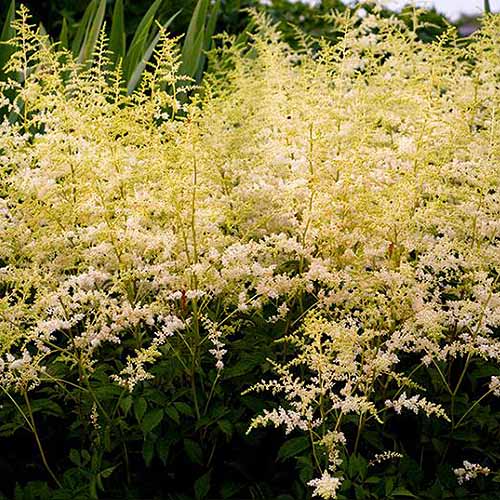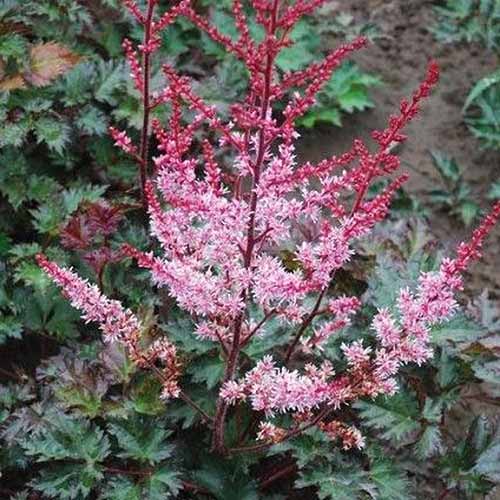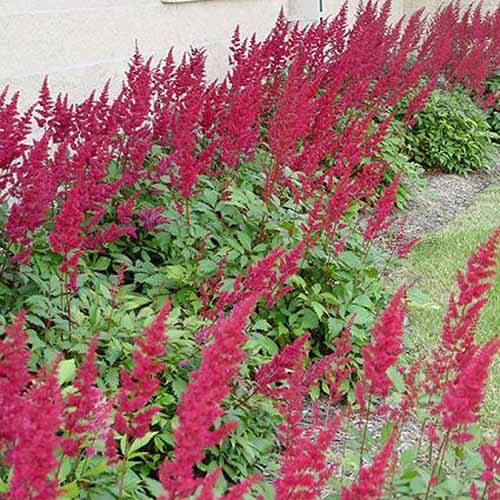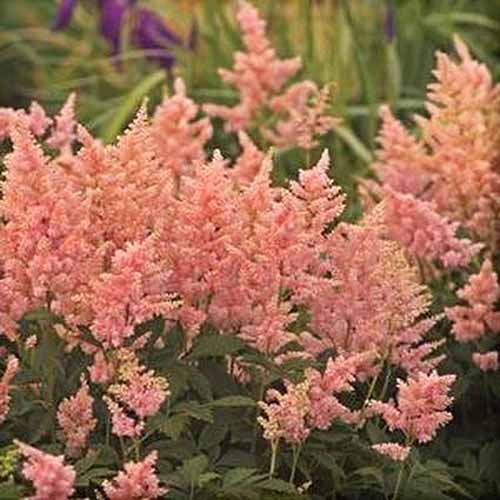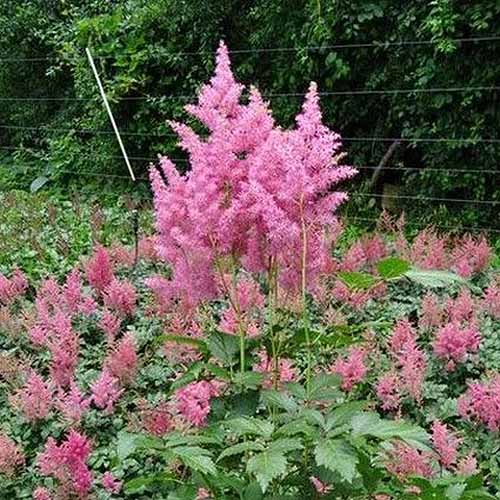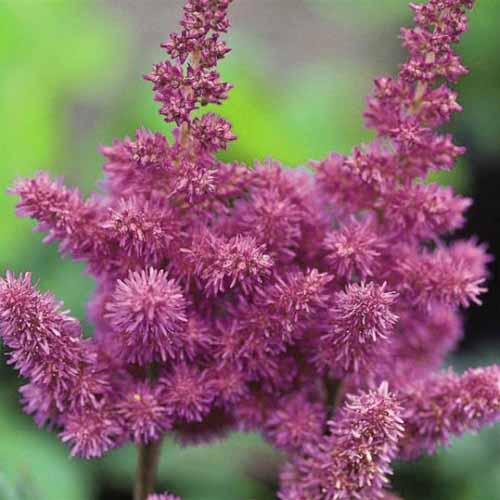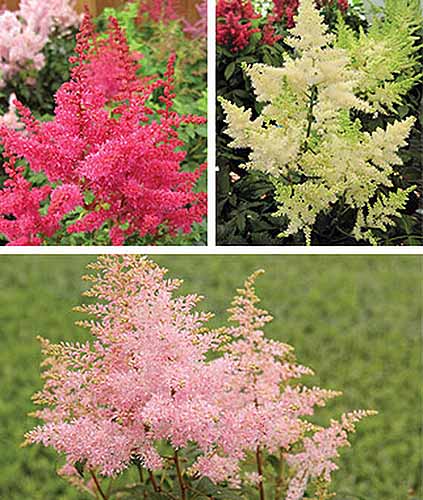When it comes to gardening in a shaded location, many of us turn to classic fallback options like hostas and foxgloves. Astilbe is a perennial that blooms for up to three weeks, producing elegant spikes or clusters of flowers.
Find the perfect cultivars for your shady areas with this guide.
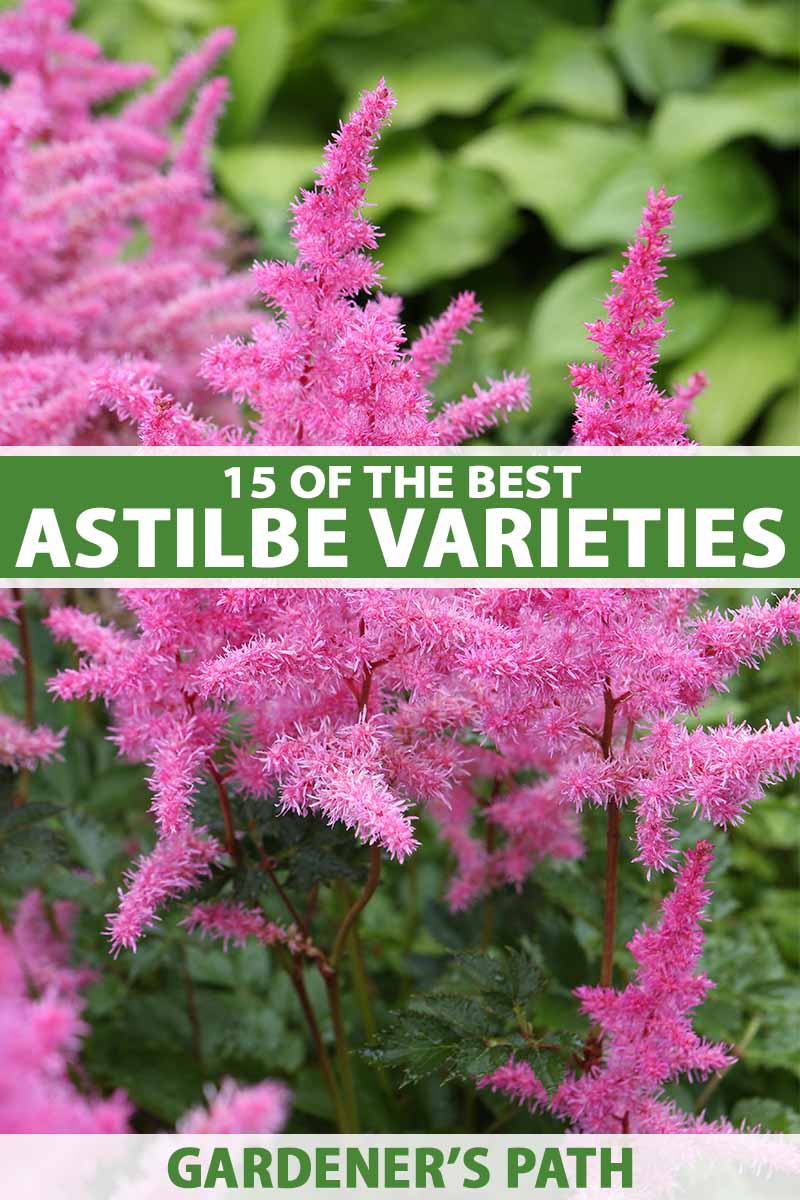
We link to vendors to help you find relevant products. If you buy from one of our links, we may earn a commission.
Multiple varieties of astilbe are available for you to choose from, with flowers covering a broad spectrum of colors. The foliage varies too, ranging from a deep green to a darker brown tone and everything in between.
It’s also incredibly easy to grow. You can view tips on how to do that in our guide to growing astilbe.
With so many gorgeous combinations of foliage and flowers for you to choose from, astilbe is a wonderful addition to the shade garden.
Let’s get started:
15 of the Best Astilbe Varieties
No matter what kind of overall look you are trying to achieve in your garden, it’s likely that there is an astilbe variety to suit your needs.
First cultivated in the late 18th century, these plants are the perfect choice for the shade garden, though there are some that can be grown in sunnier conditions as well.

There are 18 different species in the Astilbe genus and numerous hybrid cultivars. The most commonly grown species in home gardens include A. chinensis, A. japonica, A. thunbergii, and A. simplicifolia along with a large number of hybrids.
In the late 19th and early 20th century, George Arends, a plant breeder from Germany developed named hybrid cultivars known collectively as A. x arendsii.
All types of astilbe offer a feathery texture with tall spires of flowers, though the color of these blooms will vary depending on the variety you are growing.
Most species and hybrids have compound leaves, with the exception of A. simplicifolia, which sports simple leaves.
Most varieties can thrive in any soil type, from clay to sand.
Regardless of the species or cultivar, all astilbe plants are perennials that thrive in shade and moist soil.
They require minimal maintenance although you may wish to divide old plants about once every three to four years to keep them healthy, since they spread via underground rhizomes and may begin to crowd each other out.
All of the varieties listed below are known for attracting pollinators like hummingbirds and butterflies, and they are deer-resistant.
1. Bridal Veil
A cultivar of A. x arendsii, these German hybrids are generally hardy in Zones 5-8, although there are some, like ‘Fanal,’ (which we’ll get to later in this roundup) that can be grown in the colder climates of Zone 3 or 4.
Flowers of this species bloom in the early or middle part of the growing season. ‘Bridal Veil’ produces soft vertical plumes of creamy white flowers. The foliage is a glossy green, rising to about 30 inches tall. Plants spread to 18 inches wide.
‘Bridal Veil’ looks gorgeous when grouped into a shady perennial border. It does well in the sun as well as in partial shade.
You can find plants in #1 containers available from Nature Hills Nursery.
2. Chocolate Shogun
Hardy in Zones 5-9, this cultivar will have you thinking of dessert!
With intense dark chocolate-colored foliage and lacy pink flower spikes, A. thunbergii ‘Chocolate Shogun’ is an elegant flower that will look wonderful in a dried or cut flower arrangement.
A widely adaptable plant suited to slightly warmer climates than other types, it can be grown in partial shade as well as in full sun in warmer zones, as long as you provide it with plenty of moisture and mulch.
With deeply pigmented foliage, ‘Chocolate Shogun’ works well in a perennial border. It can be grown in a single row or with multiple companions, as long as the plants are spaced about two feet apart.
It grows to about 24 inches tall and 18 inches wide at maturity.
You can purchase these plants in #1 containers from Nature Hills Nursery.
3. Delft Lace
A. chinensis ‘Delft Lace’ produces lacy blue-green foliage and feathery pink blossoms on red stems that remain colorful for weeks, produced primarily in the middle of summer, in July or August.
It grows to about three feet tall and just under two feet wide.
This Chinese astilbe cultivar should be grown in partial shade and is hardy in Zones 4-8. It looks especially striking when planted among large-leaved hosta plants.
This long-blooming perennial can be purchased in #1 containers from Nature Hills Nursery.
4. Fanal
This cultivar of A. x arendsii produces deep red flowers and lacy foliage that changes colors with the seasons.
Although the foliage begins bronze with new growth, it will darken to a deeper shade of brown as the season progresses.
It’s the perfect accent to a fall garden, growing to about 24 inches tall and 12 inches wide.
‘Fanal’ is prized for its use in cut flower bouquets. It does not need to be cut back in the winter as the foliage provides interest in the garden even after the flowers have long faded.
Instead, any pruning can be done in the early spring. It is hardy in Zones 3-8.
You can find ‘Fanal’ available in #1 containers at Nature Hills Nursery.
5. Hennie Graafland
A. simplicifolia plants tend to be smaller than other options, producing fine foliage and feathery blooms.
‘Hennie Graafland’ is a delightful pint-sized pick that’s well-suited to containers. This compact plant only grows to about 10 to 18 inches tall and 24 inches wide.
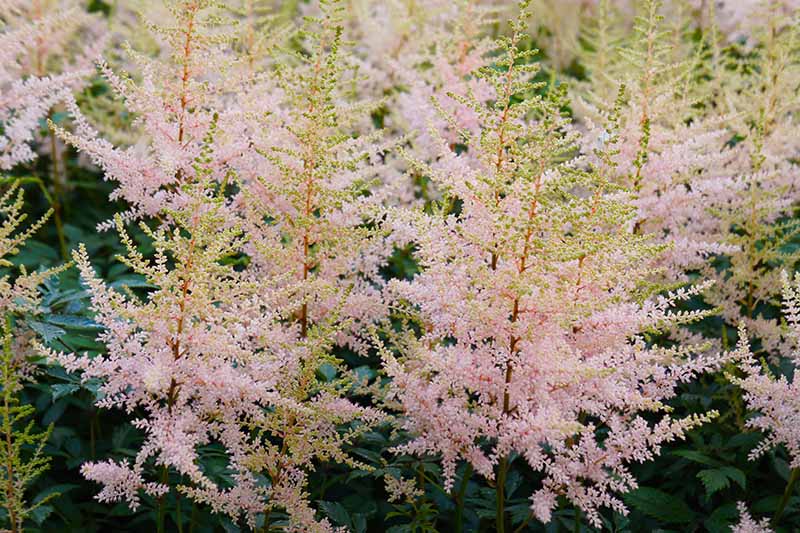
It is not the most drought-tolerant kind of astilbe you can grow. The soil should remain moist at all times, especially if you are growing in a container where the soil is prone to drying out more quickly.
This plant, which grows best in Zones 4-9, produces showy plumes of pale pink flowers that are small and delicate.
These flowers last for several weeks, making ‘Hennie Graafland’ a ideal choice for brightening up a garden where growing sun-loving flowers might not be possible.
6. Maggie Daley
A. chinensis ‘Maggie Daley’ is best known for its bright purple clusters of flowers that appear atop bright green foliage.
It’s a late-flowering variety of astilbe, producing flowers toward the middle to end of summer. It grows to about 28 inches tall and 20 inches wide.

It is hardy in Zones 4-9 and is best grown in full to partial shade.
Although all types of astilbe varieties are known for their ability to attract butterflies and other pollinators, this variety has one of the best reputations for doing so.
7. Peach Blossom
If you are looking for early season bloomers, Japanese hybrids, A. x japonica, should suit you nicely. There’s nothing quite as charming as a peach blossom, and this cultivar truly lives up to its name.
A graceful clumping perennial, ‘Peach Blossom’ produces elegant plumes of pale pink flowers in the spring and early summer months.
With glossy green divided foliage, this cultivar can be grown in full sun or partial shade.
Hardy in Zones 3-8, this cultivar grows an average of two to three feet tall and wide.
This variety can be purchased in #1 containers from Nature Hills Nursery.
8. Pumila
A. chinensis var. pumila is sure to brighten up your garden in late summer. A dwarf variety, it is aptly named, since pumila means “small” in Latin.

This variety produces elegant, slender clusters of pink or purple flowers and fine fern-like foliage.
Only reaching mature heights of about eight to 12 inches tall and 12 to 16 inches wide, this cultivar won an Award of Garden Merit from the Royal Horticultural Society in 1993.
It is hardy in Zones 4-9 and can be planted in full sun if you live in an area that experiences cool summers.
9. Red Sentinel
A. x japonica ‘Red Sentinel’ makes a serious impact when grown among other perennial plants. It offers eye-catching clusters of bright scarlet flowers that appear as early as the beginning of summer in lacy plumes.
It grows in 18-inch-wide clumps that reach mature heights of more than two feet tall.
This cultivar grows best in full shade to partial sun. It is a marvelous flower to choose if you are interested in cutting flower stalks to enjoy in a vase indoors.
‘Red Sentinel’ bare root plants are available for purchase from Burpee.
10. Rheinland
A showy, elegant perennial for shady environments in Zones 4-8 or perhaps even Zone 9, A. x arendsii ‘Rheinland’ has feathery pink blossoms and mounds of dark green foliage that give it a light, fairytale-like quality.
It grows best in full or dappled shade.
This variety grows to about 24 inches tall and wide.
You can find plants in #1 containers available from Nature Hills Nursery.
11. Sprite
A. simplicifolia ‘Sprite’ is another cultivar that received an Award of Garden Merit from the RHS in 1993. It produces lovely flowers in coral pink.
This is a dwarf type that is known for its tiny, delicate blooms. As you might guess from the plant’s name, this hybrid only reaches about two feet or so in both height and width at maturity.
Perfect for borders and raised beds, this plant can also be grown in a container on the deck.
You can purchase ‘Sprite’ in #1 containers at Nature Hills Nursery.
12. Sister Theresa
A. x arendsii ‘Sister Theresa’ is a fast-growing variety that is suitable for cultivation in Zones 3-9.
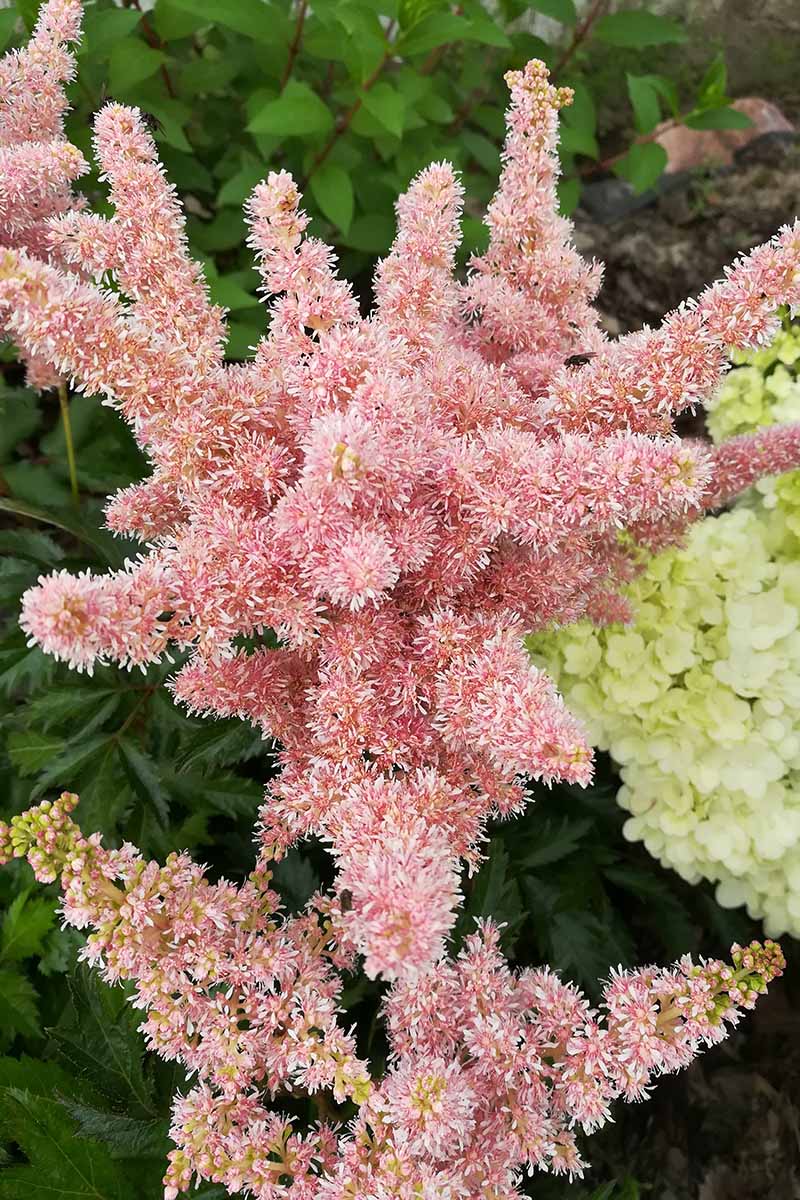
This cultivar grows from 20 to 24 inches tall and spreads just as wide, blooming early in the summer.
‘Sister Theresa’ is best known for her cotton-candy colored plumes and fine, dark-green foliage.
13. Straussenfeder
Also known as ‘Ostrich Feather,’ this A. thunbergii cultivar has coral plumes of flowers that bloom in June and July.
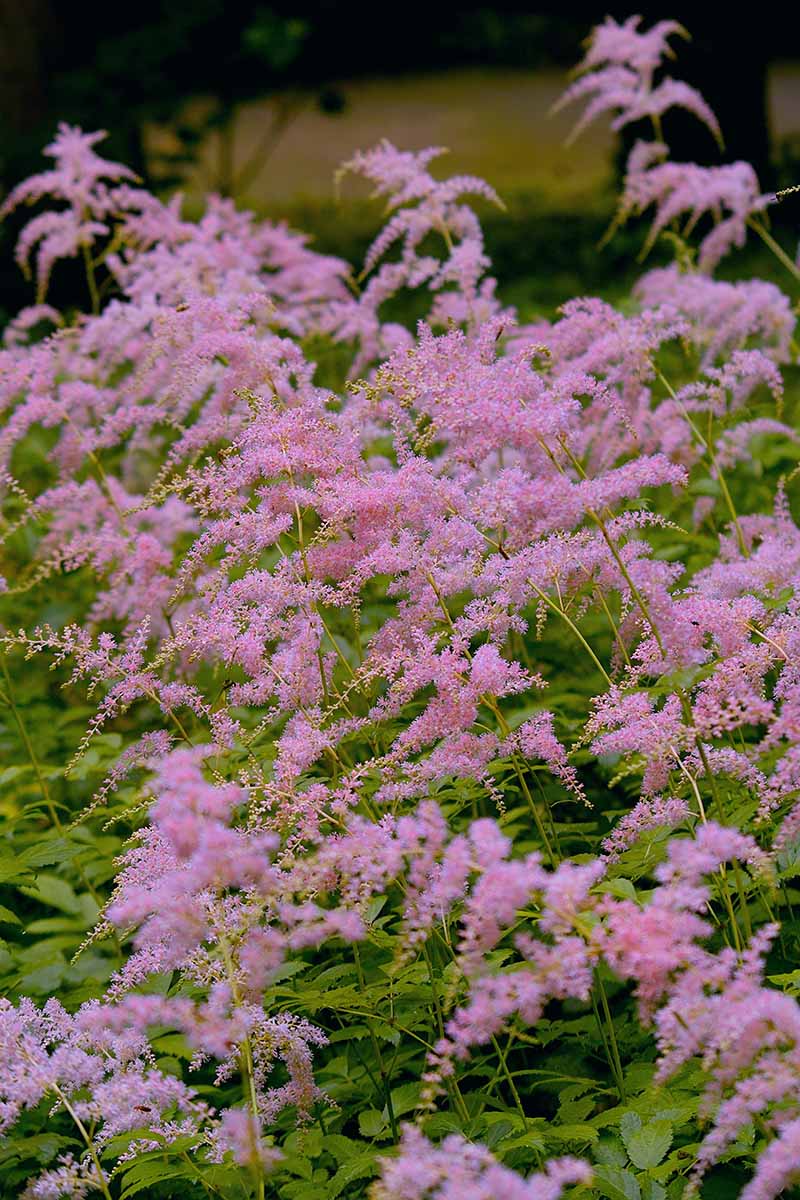
Most plants grow to about three feet tall and just one or two feet wide at maturity, with lovely dark green, mounded foliage. You may find that new foliage is tinged with bronze.
This cultivar is hardy in Zones 4-9.
14. Visions
A. chinensis ‘Visions’ is another feathery variety that produces blooms in shades of raspberry pink.
It has bronze-green glossy foliage that contrasts nicely with its warmer blossoms. It grows to about 10 inches tall and wide.
Like most Chinese astilbes, this variety is more tolerant of dry soil than some, but growers should still avoid allowing it to dry out as a rule.
It also produces fragrant flowers, something that is not found with all varieties of astilbe. The flower spikes usually appear in midsummer when grown in Zones 3-8.
You can find plants in #1 containers available at Nature Hills Nursery.
15. Younique
Younique™ is a newer series of astilbe plants that can be found with blossoms in numerous colors, including red, white, and pink, as well as cerise, lilac, salmon, silvery pink, and carmine.
Best grown in clusters with other shade-loving plants like ferns, heucheras, and hellebores, Younique™ offers color from the spring to the end of summer.
Hardy in Zones 4-9, plants in this series grow to a mature height of around 16 to 20 inches with a spread of about 14 to 18 inches.
The flowers also look wonderful when cut for bouquets or dried arrangements.
There are several cultivars of this series available, each with different blossom colors, and all are disease-resistant.
A mixed set of three bare-root plants in salmon, white, and pink is available from Burpee.
The Star of the Shade Garden
An extraordinary flowering plant, astilbe comes in a variety of shapes, sizes, and colors – and you’re sure to find one that fits your gardening needs.
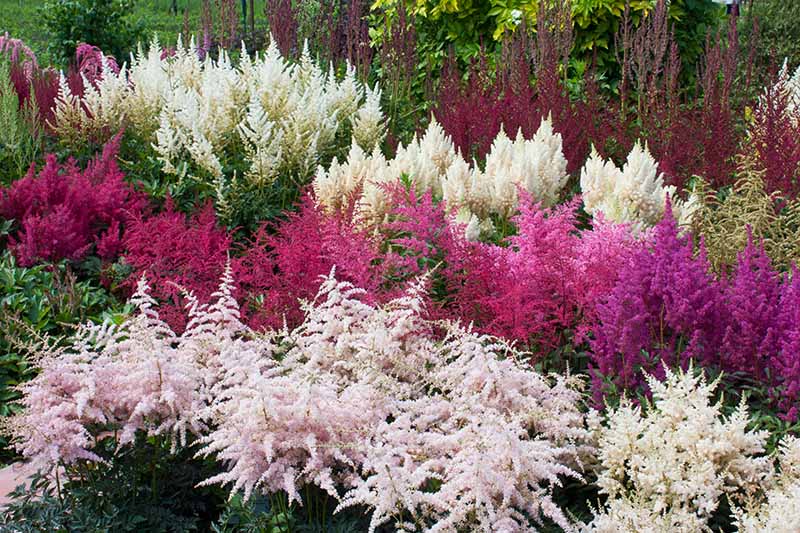
Are you growing astilbe? What’s your favorite variety? Let us know in the comments section below, and feel free to share a picture!
Want to learn more about growing astilbes in your perennial garden? Check out these articles next:
- How to Winterize Astilbe Plants: 5 Easy Steps
- How to Propagate Astilbe Flowers Through Division
- When and How to Fertilize Astilbe
© Ask the Experts, LLC. ALL RIGHTS RESERVED. See our TOS for more details. Product photos via Burpee and Nature Hills Nursery. Uncredited photos: Shutterstock. With additional writing and editing by Clare Groom and Allison Sidhu.
